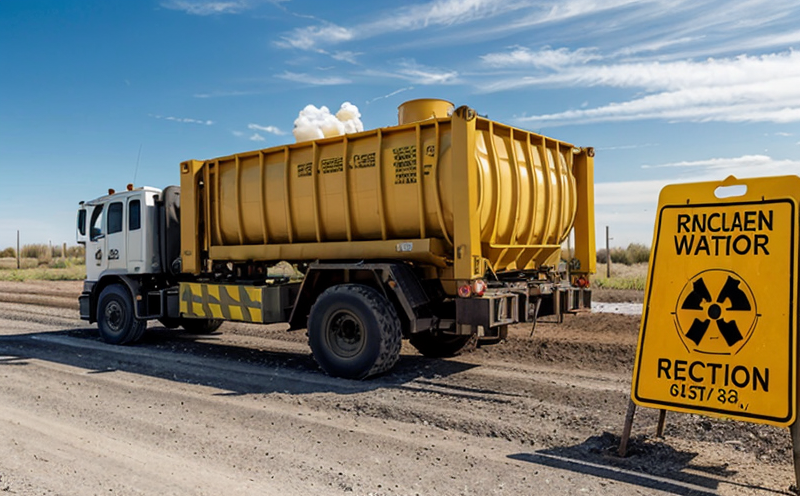EN 259 Leaching Behaviour of Cemented Radioactive Waste
The EN 259 standard is a crucial regulatory requirement for the testing and assessment of the leaching behaviour of cemented radioactive waste. This European-wide standard ensures that hazardous materials are safely contained, minimizing risks to human health and the environment. The primary objective of this test method is to evaluate how effectively cementitious materials can prevent the release of radioactive substances into the surrounding environment.
The process involves the controlled leaching of radioactive waste material from a solid matrix into an aqueous solution under defined conditions. This allows for quantification of radionuclide releases, which helps in understanding potential environmental impacts. The test is performed using a set protocol that includes specific parameters such as temperature, duration, and pH levels to simulate real-world conditions.
For accurate testing, the specimen preparation is critical. Samples are typically taken from waste forms like drums or blocks of cemented radioactive waste. These samples undergo rigorous characterization before undergoing leaching tests. Characterization may involve determining particle size distribution, moisture content, and physical structure using techniques such as scanning electron microscopy (SEM) and X-ray diffraction (XRD).
The testing process itself involves placing the prepared sample in a vessel filled with an aqueous solution at specified conditions. The solution is then allowed to interact with the waste form over a defined period. After leaching, the effluent is analyzed for radionuclide concentrations using highly sensitive detection methods like liquid scintillation counting or gamma spectrometry.
Accurate and consistent reporting of results is paramount in ensuring regulatory compliance and public confidence. Reports must detail all procedural steps followed during testing as well as the final quantitative data on radionuclide release rates. Compliance with EN 259 ensures that radioactive waste management practices meet stringent international standards, thereby enhancing safety protocols.
Understanding the broader context of this service is essential for stakeholders involved in nuclear waste management. The accurate characterization and safe containment of hazardous materials are critical components of effective environmental stewardship. By adhering to such rigorous testing methods as specified by EN 259, organizations contribute significantly towards safeguarding public health and protecting ecosystems.
Real-world applications of this service extend beyond mere compliance; it plays a pivotal role in advancing safer nuclear waste management practices globally. As technology evolves, so too must our understanding of how best to handle hazardous materials responsibly. Through continuous research informed by rigorous testing like that conducted according to EN 259, we can develop more effective strategies for mitigating risks associated with radioactive waste.
Why It Matters
The importance of the EN 259 leaching test cannot be overstated when it comes to managing cemented radioactive waste effectively. This test serves as a vital tool in ensuring that hazardous materials remain securely contained and do not pose undue risks either during storage or disposal processes.
- Risk Reduction: By accurately quantifying the release rates of radionuclides, this testing process helps identify potential weak points in current containment methods. This information can be used to improve future designs and materials for safer waste management.
- Compliance Assurance: Adhering to international standards like EN 259 ensures that organizations meet stringent regulatory requirements set forth by various governmental bodies responsible for nuclear safety and environmental protection.
- Environmental Protection: Accurate assessment of leaching behaviour contributes significantly towards minimizing the spread of radioactive contaminants into soil, water bodies, or air. This helps in maintaining ecological balance around facilities handling such wastes.
The continuous monitoring provided by tests like these is crucial for sustaining long-term environmental sustainability goals while also fostering trust among communities near nuclear facilities.
Quality and Reliability Assurance
- Standard Operating Procedures: Rigorous adherence to prescribed protocols ensures consistent results across different batches of samples. This consistency is vital for obtaining reliable data that can be used effectively in decision-making processes.
- Calibration Checks: Regular calibration of instruments involved in testing guarantees accurate measurements every time, reducing the margin of error and enhancing overall confidence in test outcomes.
In addition to these procedural measures, there are several other factors that contribute to maintaining high standards of quality assurance. These include robust quality control programs, ongoing staff training on latest developments within the field, and regular audits by independent third parties familiar with best practices in radioactive waste management.
Quality assurance is not just about following procedures; it also involves continuous improvement based on feedback from stakeholders involved at all levels—from laboratory technicians to regulatory authorities. By adopting this holistic approach, laboratories performing EN 259 tests can ensure that their services remain dependable and trustworthy.
International Acceptance and Recognition
- Global Standardization: The adoption of EN 259 as an international standard underscores its significance in the field. This recognition ensures that findings derived through this testing method are universally accepted, facilitating smoother cross-border collaboration among experts.
- Cross-Acceptance: Laboratories accredited to perform EN 259 tests enjoy broad acceptance from regulatory bodies worldwide. This means that test results obtained under these standards can be relied upon globally without additional scrutiny or retesting.
The widespread usage of this standard across different countries highlights its value as a benchmark for excellence in radioactive waste management practices. Its international recognition further strengthens the credibility and reliability of laboratories specializing in performing EN 259 tests.





